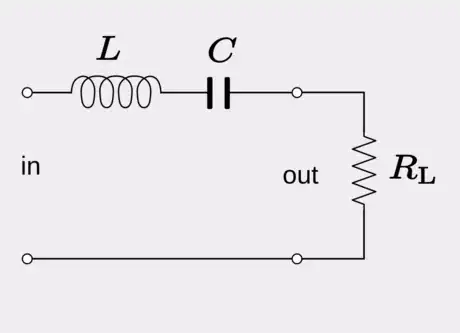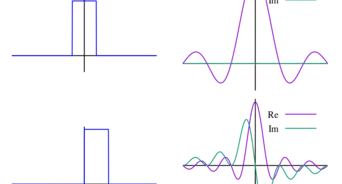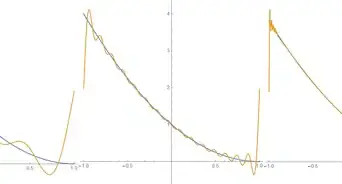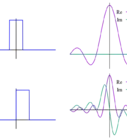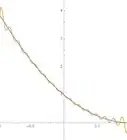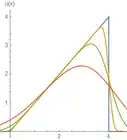X
wikiHow is a “wiki,” similar to Wikipedia, which means that many of our articles are co-written by multiple authors. To create this article, volunteer authors worked to edit and improve it over time.
This article has been viewed 22,910 times.
Learn more...
The series RLC circuit is a circuit that contains a resistor, inductor, and a capacitor hooked up in series. The governing differential equation of this system is very similar to that of a damped harmonic oscillator encountered in classical mechanics.
Steps
Part 1
Part 1 of 3:
No Voltage Source
-
1Use Kirchhoff's voltage law to relate the components of the circuit. Kirchhoff's voltage law for a series RLC circuit says that where is the time-dependent voltage source. In this section, we investigate the case without this source to obtain the solution to a homogeneous equation. We then tackle the slightly more complicated task of finding the steady-state solution. The diagram above shows an example of an RLC circuit.
- Electric current is related to charge by the relation where is electric charge and the dot signifies a time derivative.
- Ohm's law says that the voltage across a resistor is linearly proportional to the current: This can be written as
- The voltage across an inductor is given by where is the inductance. As before, we can write this as
- The voltage across a capacitor is given by the relation
- The governing differential equation is then given below.
-
2Relate the coefficients to the standard form of the harmonic oscillator equation.
- This more applicable form of the equation is given below. We can see from inspection that and refers to the frequency of the system, while is a parameter, also in units of angular frequency, that simplifies calculations. This parameter is called the attenuation and measures how quickly the transient response of the circuit dies away. We can apply this equation to the classical harmonic oscillator as well, or any system whose behavior is predominantly oscillatory in nature.
Advertisement - This more applicable form of the equation is given below. We can see from inspection that and refers to the frequency of the system, while is a parameter, also in units of angular frequency, that simplifies calculations. This parameter is called the attenuation and measures how quickly the transient response of the circuit dies away. We can apply this equation to the classical harmonic oscillator as well, or any system whose behavior is predominantly oscillatory in nature.
-
3Solve the characteristic equation to find the complementary solution.
- The solutions to the characteristic equation are very simple, and we can see why we deal with this equation instead.
- We know that physically, the capacitance is usually a very small quantity. Capacitors are usually measured in nanofarads or microfarads, whereas resistors can be on the order of ohms to megaohms. It is therefore not unreasonable to suggest that so that the square root is negative and the solutions are oscillatory rather than exponential in nature. From the theory of differential equations, we obtain the complementary solution, where we write as the damped frequency.
- The solutions to the characteristic equation are very simple, and we can see why we deal with this equation instead.
-
4Rewrite the solution in the form with a phase factor. We can convert this solution into a slightly more familiar form by performing the following manipulation.
- Multiply the solution by
- Draw a right triangle with angle hypotenuse length opposite side length and adjacent side length Replace the constant with a new constant denoting amplitude. Now we can simplify the quantities in parentheses. The result is that the second arbitrary constant has been replaced with an angle.
- Because is arbitrary, we can also use the cosine function as well. (Mathematically, the two phase factors are different, but in terms of finding the equation of motion given initial conditions, only the form of the solution matters.)
- Multiply the solution by
-
5Find the time-dependent current. Current is just one derivative away, which is why we solved the problem in terms of charge. In practice, however, it is much easier to measure current than it is to measure charge.
- It turns out that in practice, the attenuation is very small, so This approximation gets better the smaller is.
- This form of the solution, a linear combination of sine and cosine, suggests that we can again rewrite the solution in terms of just one term. Note that the amplitude and phase factor are mathematically different from the previous term, but as we are not given initial conditions, there is no physical difference.
Advertisement
Part 2
Part 2 of 3:
Sinusoidal Voltage Source
-
1Consider a sinusoidal voltage source. This voltage source is in the form where is the amplitude of the voltage and is the frequency of the signal. The differential equation is now inhomogeneous. By linearity, any solution to the inhomogeneous equation added to the complementary solution gives the general solution.
-
2Use the method of undetermined coefficients to find the particular solution. From the theory of differential equations, we compare the source term to and find if the source contains a term that is times a term in or not, where is 0 or a positive integer. Because there aren't any, the particular solution will take on the following form.
-
3Substitute into the differential equation and equate the two coefficients.
- After some algebra and comparing the coefficients of and we arrive at a system of algebraic equations.
- These two equations can be written in a more suggestive form.
- After some algebra and comparing the coefficients of and we arrive at a system of algebraic equations.
-
4Solve for the coefficients. We solve for in terms of find then find as a result.
- Use the second equation to solve for in terms of
- Substitute back into the first equation to find
- From here, we immediately find
- Use the second equation to solve for in terms of
-
5Arrive at the general solution. The coefficients give us the terms that we need in the steady-state solution. The general solution is now simply the sum of the transient and steady-state solutions.
Advertisement
Part 3
Part 3 of 3:
Resonance
-
1Assume the ansatz steady-state solution . We have already found the steady-state solution in terms of parameters that we know. Our form of the steady-state solution, a linear combination of sine and cosine, suggests that we can also write it in terms of amplitude and phase factor, just as we did with the transient term. As we will shortly see, this provides a more useful formulation with which to analyze resonance.
-
2Substitute into the differential equation. Now, we solve for the amplitude and phase both functions of the driving frequency
- We must make use of the following trigonometric identities in our work.
- After substituting and making use of the summation identities, we arrive at the following system of equations.
- We must make use of the following trigonometric identities in our work.
-
3Solve for the phase factor . We can use the second equation to do this.
- Our previous results suggest that we write out the denominator as The difference is primarily one of bookkeeping.
-
4Solve for the amplitude . We use the first equation to do this.
- To find and draw a right triangle with angle adjacent side length opposite side length and hypotenuse. Make sure to draw the triangle so that is negative.
- We now have all the information needed to find
- After some simplification, we arrive at the following result.
- To find and draw a right triangle with angle adjacent side length opposite side length and hypotenuse. Make sure to draw the triangle so that is negative.
-
5Write the steady-state term in terms of current. Current is once again a derivative away. Note that is an odd function.
-
6Identify the conditions for resonance.
- Assume that the attenuation is set to 0, or Then the magnitude of the amplitude of the steady-state term is given as the following.
- We see that as the amplitude increases without bound. This condition is called resonance. An RLC circuit satisfies resonance under the following condition.
- The driving force will also have a phase shift of relative to the steady-state response when resonance is met.
- Assume that the attenuation is set to 0, or Then the magnitude of the amplitude of the steady-state term is given as the following.
-
7Find the frequency at which maximum amplitude occurs. One only take the derivative, set it to 0, and solve for Notice that the term means that the maximum amplitude occurs at a frequency slightly lower than the resonant frequency. But also note that as gets smaller, gets closer to
-
8Find the maximum amplitude. Simply substitute our result, and simplify.
- We may also write our solution in terms of the amplitude at resonance.
Advertisement
About This Article
Advertisement
